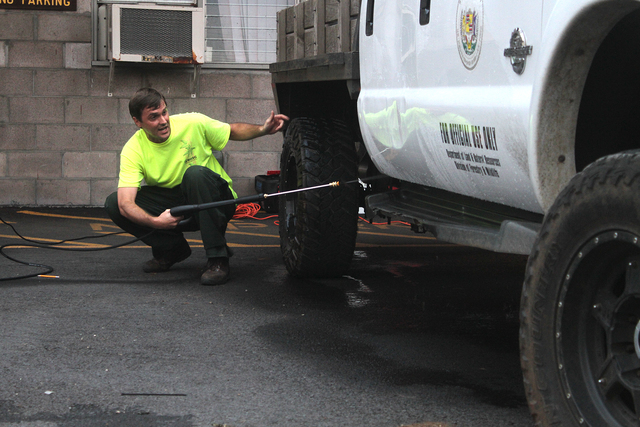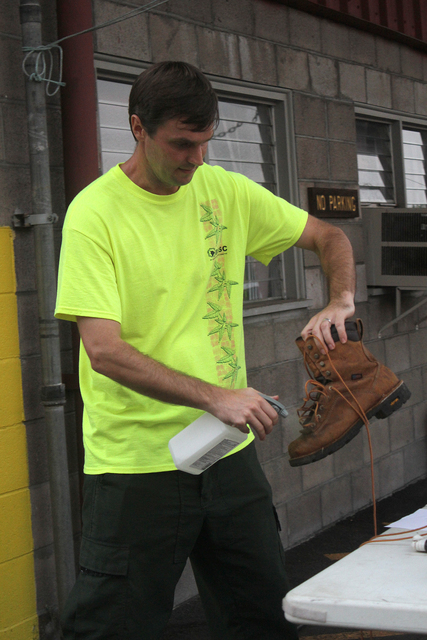HILO — Corie Yanger wrote the word “ohia” on a whiteboard and asked the 30 other people in the room to call out reasons why the tree was special to them. ADVERTISING HILO — Corie Yanger wrote the word “ohia”
HILO — Corie Yanger wrote the word “ohia” on a whiteboard and asked the 30 other people in the room to call out reasons why the tree was special to them.
She wrote each statement — native to Hawaii, watershed species, hula, home for birds, food for bees, first tree to grow after a lava flow — as a spoke coming off the center ohia wheel.
Then Yanger, an educational specialist with the University of Hawaii College of Tropical Agriculture and Human Resources, erased ohia from the center, leaving only a blank space.
“What we’re here to talk about is that possibility, and I think we all know how serious that would be,” she said.
Public outreach to raise awareness of the ongoing threat to Hawaii’s ohia trees, the fungal disease called Rapid Ohia Death, has increased over the past year. Yanger and CTAHR extension forester J.B. Friday have given about 80 public presentations in 2016.
A Thursday evening meeting held at the Hilo Department of Land and Natural Resources Division of Forestry and Wildlife building featuring an update on ROD research and a demonstration of best practices for decontaminating gear, tools and vehicles (participants received their own decontamination kit) was the latest stop.
Friday pointed out during his presentation that it was thanks to the public that ROD was first noticed, as property owners began to notice their ohia trees’ leaves browning. In a matter of weeks, the trees would be dead.
“This isn’t something that scientists discovered,” Friday said. “People on the ground, on the island, discovered it, and called us asking why their trees were dying.”
U.S. Department of Agriculture pathologist Lisa Keith and her team at the Pacific Basic Agricultural Research Center have since isolated two different species of Ceratocystis fungus that cause the disease. Both species are entirely new and found nowhere else in the world.
Having two new species at once was “really quite a puzzle,” Friday said.
Scientists believe that one species, introduced from Latin America, had been here for some time “humming along, causing some disease,” Friday said. But it was never formally identified because nobody thought to look for it.
The other species, introduced from Southeast Asia, is newer. Ceratocystis species are found around the world and affect other tree species like eucalyptus and acacia.
On the Big Island, more than 50,000 acres of forest have been affected by ROD. It has not been found on other islands thanks in part to a Department of Agriculture quarantine on inter-island ohia transport put in place last year.
Both Ceratocystis introductions underscore the need for better biosecurity, Friday said.
“The DOA guys that are on the front lines are doing a great job, but there’s not enough of them to stop everything from coming in,” he said.
Once the fungi arrived, they proved adept at moving around the island. This is in part thanks to airborne spores and sawdust frass created by boring beetles.
People also can move infected logs from place to place, or unwittingly transport spores while hiking or working in ROD-infected areas.
The demonstration portion of Thursday’s program was intended to help stop the latter type of transport.
“Even if you feel everything’s clean, best practice is decontamination,” said Big Island Invasive Species Committee field technician Joel Brundage. “At least (for) your boots.”
Boots, with their treads and small lace eyelets, are prime places for spores to hide out.
Brundage recommended using a solution of 70 percent rubbing alcohol to spray equipment before scrubbing it down. A 10 percent bleach solution can also be used, but bleach can be corrosive to gear like machetes.
Cleaning should be done before going out into the forest, Brundage said, but post-trip is “when you really, really want to clean.”
He demonstrated spraying off vehicles using a power washer or special hose attachment that increases water force. When people clean their cars, they’re usually trying to make the paint and exterior look better.
“That’s not what we’re looking for with decontamination,” Brundage said as he sprayed the undercarriage, mud flaps, and tire treads.
The presenters acknowledged that even best practices could not entirely prevent ROD spread.
“It’s better to take care of 90 percent of it instead of throwing your hands up and doing nothing about it,” Friday said.
Nadine Robertson said she had attended the evening program for the chance to talk one-on-one with the experts.
“You can read the reports and read about it online … you get a better feeling when you get to talk to people,” she said.
Robertson is on the board of directors for the Hawaii Wildlife Fund. She also has a handful of ohia on her own property.
“The few that we have, I’d love them to be healthy,” she said.
For more information about Rapid Ohia Death visit www.rapidohiadeath.org.
Email Ivy Ashe at iashe@hawaiitribune-herald.com.




